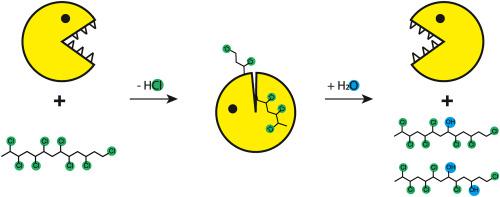Chemosphere ( IF 8.1 ) Pub Date : 2020-09-11 , DOI: 10.1016/j.chemosphere.2020.128288
Marco C. Knobloch , Lena Schinkel , Iris Schilling , Hans-Peter E. Kohler , Peter Lienemann , Davide Bleiner , Norbert V. Heeb

|
Short-chain chlorinated paraffins (SCCPs) are listed as persistent organic pollutants (POPs) under the Stockholm Convention. Such substances are toxic, bioaccumulating, transported over long distances and degrade slowly in the environment. Certain bacterial strains of the Sphingomonadacea family are able to degrade POPs, such as hexachlorocyclohexanes (HCHs) and hexabromocyclododecanes (HBCDs). The haloalkane dehalogenase LinB, expressed in certain Sphingomonadacea, is able to catalyze the transformation of haloalkanes to hydroxylated compounds. Therefore, LinB is a promising candidate for conversion of SCCPs. Hence, a mixture of chlorinated tridecanes was exposed in vitro to LinB, which was obtained through heterologous expression in Escherichia coli. Liquid chromatography mass spectrometry (LC-MS) was used to analyze chlorinated tridecanes and their transformation products. A chloride-enhanced soft ionization method, which favors the formation of chloride adducts [M+Cl]- without fragmentation, was applied. Mathematical deconvolution was used to distinguish interfering mass spectra of paraffinic, mono-olefinic and di-olefinic compounds. Several mono- and di-hydroxylated products including paraffinic, mono-olefinic and di-olefinic compounds were found after LinB exposure. Mono- (rt=5.9-6.9 min) and di-hydroxylated (rt=3.2–4.5 min) compounds were separated from starting material (rt=7.7-8.5 min) by reversed phase LC. Chlorination degrees of chlorinated tridecanes increased during LinB-exposure from nCl=8.80 to 9.07, indicating a preferential transformation of lower chlorinated (Cl<9) tridecanes. Thus, LinB indeed catalyzed a dehalohydroxylation of chlorinated tridecanes, tridecenes and tridecadienes. The observed hydroxylated compounds are relevant CP transformation products whose environmental and toxicological effects should be further investigated.
中文翻译:

细菌卤代烷脱卤酶LinB转化短链氯化石蜡–单羟基和二羟基代谢物的形成
短链氯化石蜡(SCCP)在《斯德哥尔摩公约》下被列为持久性有机污染物(POPs)。这些物质是有毒的,具有生物蓄积性,可以长距离运输并在环境中缓慢降解。Sphingomonadacea家族的某些细菌菌株能够降解POP,例如六氯环己烷(HCH)和六溴环十二烷(HBCD)。在某些Sphingomonadacea中表达的卤代烷脱卤酶LinB能够催化卤代烷转化为羟基化合物。因此,LinB是SCCP转换的有希望的候选者。因此,将氯化十三烷的混合物在体外暴露于LinB,后者是通过在大肠杆菌。液相色谱质谱法(LC-MS)用于分析氯化十三烷及其转化产物。采用了一种氯化物增强的软电离方法,该方法有利于氯离子加成物[M + Cl] -的形成,而不会发生断裂。数学解卷积用于区分链烷烃,单烯烃和二烯烃化合物的干扰质谱。LinB暴露后发现了几种单羟基和二羟基化产物,包括链烷烃,单烯烃和二烯烃化合物。通过反相液相色谱从起始原料(rt = 7.7-8.5 min)中分离出单峰(rt = 5.9-6.9 min)和二羟基化(rt = 3.2-4.5 min)化合物。LinB接触n Cl时,氯化十三烷的氯化度增加= 8.80至9.07,表明低级氯化(Cl <9)十三烷的优先转化。因此,LinB确实催化了氯化十三烷,十三烯和十三二烯的脱卤羟基化反应。观察到的羟基化化合物是相关的CP转化产物,其环境和毒理作用应进一步研究。

































 京公网安备 11010802027423号
京公网安备 11010802027423号